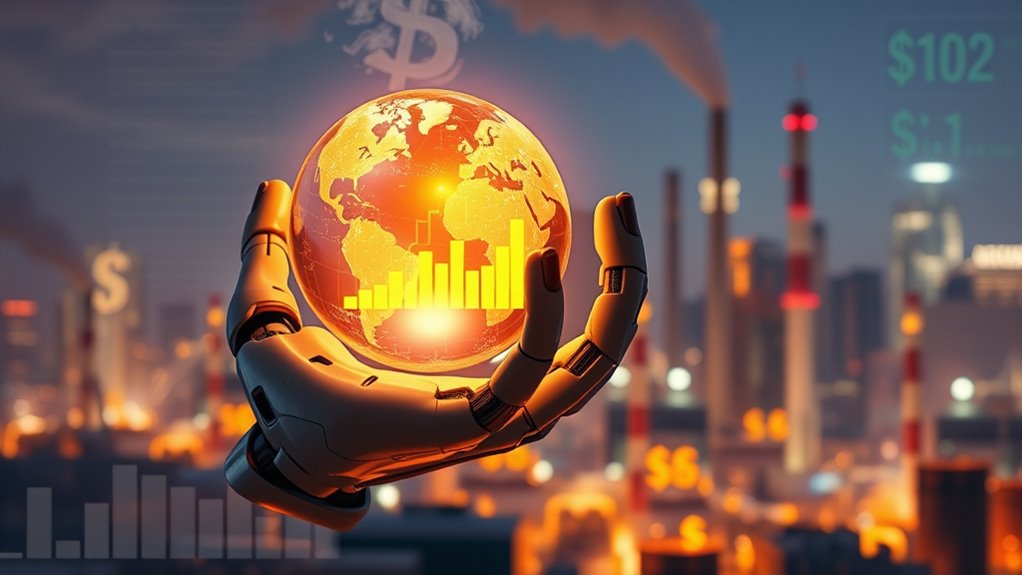AI can both drive prices up and down in the short term. Its adoption boosts efficiency and lowers costs, which may reduce inflation over time. But increased demand from AI investment and rapid price adjustments through algorithms can cause temporary price hikes. Regional differences, supply chain improvements, and workforce shifts also influence inflation dynamics. To understand how these opposing forces create a complex picture, keep exploring how AI’s impact on inflation unfolds across different scenarios.
Key Takeaways
- AI boosts productivity, potentially lowering costs and prices in the long term, but initial investments may cause short-term inflation.
- Algorithmic pricing and real-time data analysis enable firms to adjust prices dynamically, impacting inflation volatility.
- AI-driven demand increases can temporarily raise prices, especially if access is uneven across regions.
- Supply chain efficiencies from AI can temper inflation pressures over time through improved logistics.
- Labor market shifts to AI-skilled workers may increase wages, contributing to inflationary pressures in certain sectors.
The Short-Term Impact of AI on Inflation Dynamics

In the short term, AI can substantially influence inflation dynamics by creating economic imbalances and altering demand and supply. You might see increased demand driven by AI-driven productivity and innovation, which can lead to modest inflation rises. As AI boosts spending among consumers and businesses, prices could temporarily climb. Central banks will likely respond by adjusting interest rates to counteract these shifts, aiming to stabilize the economy. Meanwhile, AI’s predictive analytics help policymakers forecast inflation more accurately, allowing for timely interventions. Additionally, short-term economic growth fueled by AI may push prices higher, especially if demand outpaces supply. However, AI’s ability to improve supply chain efficiency and resolve imbalances quickly could eventually temper inflationary pressures, though these effects unfold over a relatively brief period. AI’s role in economic forecasting can further enhance policymakers’ ability to respond swiftly to inflationary trends. Moreover, understanding market responses to technological change can aid in anticipating long-term inflation trajectories.
How AI Adoption Enhances Business Efficiency and Cost Management

AI adoption markedly boosts business efficiency and cost management by automating routine tasks and providing data-driven insights. You can optimize operations, improve data accuracy, and enhance cybersecurity, leading to measurable productivity gains. Over 92% of businesses report positive results from AI, especially in reducing costs and streamlining processes. AI tools automate tasks in finance, customer support, and other functions, freeing your workforce for strategic initiatives. Cost savings are significant—many companies see at least a 1% positive impact. By integrating AI into various departments, you gain a competitive edge, improve decision-making, and boost overall productivity. As a result, AI not only enhances operational efficiency but also helps manage costs more effectively, supporting sustained growth and economic resilience.
Regional Variations in AI Readiness and Economic Outcomes

Regional differences in AI readiness considerably shape economic outcomes, with some countries leveraging robust infrastructure and policies to accelerate adoption, while others face hurdles that slow progress. The U.S., Singapore, the U.K., Canada, and Germany lead with strong digital infrastructure, capital markets, and supportive policies, boosting AI integration and economic resilience. Conversely, Mexico, Indonesia, Brazil, and Argentina grapple with digital infrastructure gaps, limited funding, and workforce shortages, slowing AI deployment. Countries like France and South Korea show momentum but need more investment and skill expansion for broader impact. Workforce readiness varies, with regions emphasizing upskilling and vocational training, fostering stability. Regulatory frameworks also differ; proactive policies in Germany and France facilitate responsible AI use, while uncertainty in emerging markets hampers investment and inflation management. These variations fundamentally influence regional economic outcomes. The level of digital infrastructure and policy support directly correlates with a country’s ability to harness AI for economic growth. Additionally, infrastructure development plays a crucial role in enabling effective AI deployment and innovation.
AI’s Role in Shaping the Future of Price Stability

Artificial intelligence is transforming how prices are set and adjusted across markets, making them more responsive and dynamic. With algorithmic pricing, you can see prices change more frequently and uniformly, helping markets react swiftly to economic shifts. AI reduces price stickiness, allowing firms to adjust prices more often, which can influence inflation trends. It enhances market efficiency by processing vast data quickly, leading to better price discovery. As more companies adopt AI pricing strategies, competitive dynamics shift, potentially stabilizing or destabilizing prices. AI also improves decision-making for firms, enabling data-driven responses to external factors. The integration of real-time data analysis capabilities allows markets to adapt even more quickly to changing conditions. Overall, AI’s role in price formation is shaping a future where markets respond faster, potentially leading to greater price stability or volatility, depending on how these technologies are managed. AI’s ability to analyze vast datasets in real-time further supports dynamic pricing models, enabling market participants to anticipate and react to emerging trends more effectively.
Navigating Challenges and Opportunities in AI-Driven Inflation Trends

As AI continues to reshape economic dynamics, steering its impact on inflation trends presents both significant opportunities and complex challenges. You’ll need to navigate the near-term rise in inflation driven by increased investment and demand from AI deployment. While this initial inflationary push might subside as total factor productivity improves, uneven AI access can create localized inflation spikes and disparities across regions. You must also consider how regional differences and macroeconomic variables, like exchange rates, influence outcomes. The rapid growth of the AI market and decreasing costs boost automation and productivity, offering opportunities to lower prices. However, labor market shifts and rising wage premiums for AI-skilled workers could add inflationary pressures. Balancing these factors requires strategic policies to manage disparities while maximizing AI’s economic benefits. 89% of small businesses have integrated AI tools to automate tasks, highlighting the widespread adoption that influences market prices and competitiveness. Additionally, understanding the economic impact of automation can help policymakers design effective measures to mitigate inflationary risks while fostering innovation.
Frequently Asked Questions
How Might AI Influence Inflation Differently Across Emerging and Developed Economies?
You might notice that AI influences inflation differently in emerging and developed economies. In developed countries, rapid AI-driven productivity boosts can lead to cost reductions and disinflation over time. Conversely, in emerging markets, slower AI adoption and supply-side gains may cause uneven inflation, with some areas experiencing higher costs. As AI reshapes productivity and trade, your economy’s inflation trends will depend on how quickly and effectively AI integrates into your sectors.
What Specific Policies Can Accelerate Equitable AI Adoption Globally?
You can accelerate equitable AI adoption globally by advocating for inclusive policies that support infrastructure development, especially in underserved regions. Push for international cooperation on standards and regulations to guarantee fairness. Invest in education and skills training to bridge workforce gaps. Encourage public-private partnerships to fund AI projects in diverse communities. Prioritize transparency and ethical guidelines to build trust. These actions help create a balanced AI ecosystem that benefits everyone, everywhere.
How Will Ai-Driven Productivity Gains Affect Wage Growth and Income Inequality?
Imagine a rising tide lifting some ships higher than others—that’s what AI-driven productivity can do to wages and income inequality. You might see workers with AI skills earning more, while others fall behind without access to reskilling. If benefits aren’t shared, inequality widens. You need policies that spread opportunities, ensuring everyone climbs aboard this technological wave, so productivity lifts all boats, not just a few.
Can AI Reduce Inflation Without Causing Significant Job Displacement?
You might wonder if AI can lower inflation without causing big job losses. The good news is, AI mostly enhances roles requiring judgment and automates repetitive tasks, so it doesn’t wipe out jobs. Instead, it shifts skills, creates new opportunities, and boosts productivity. As you adapt, you’ll find AI can help stabilize prices long-term while supporting employment growth, especially when combined with smart policies and upskilling efforts.
What Are the Long-Term Risks of Ai-Induced Market Monopolies on Prices?
Did you know that past monopolies like AT&T eventually spurred innovation after being broken up? Long-term, AI-induced market monopolies could lead to higher prices, reduced competition, and stifled innovation. When a few companies control data and technology, they might exploit their power to keep prices high, limiting consumer choice. If unchecked, this concentration risks stagnation and growing inequality, making regulatory oversight essential to protect market health and consumer welfare.
Conclusion
While some worry AI might push prices up through increased demand, its efficiency gains and cost reductions often help stabilize or lower inflation in the long run. By improving productivity and streamlining supply chains, AI enables you to manage costs better, even amid economic fluctuations. So, instead of fearing inflation spirals, consider AI as a tool that, if harnessed wisely, can support price stability and economic resilience.









